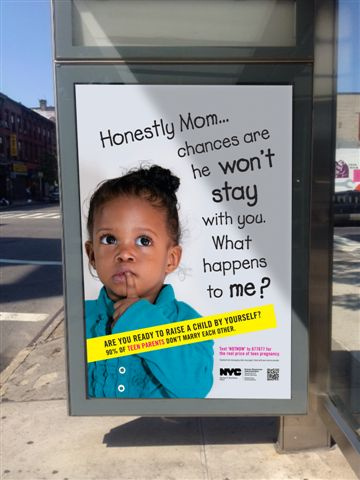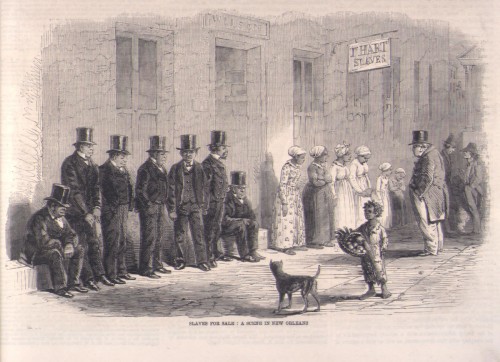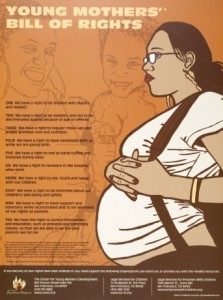The Color of Moral Panic is Black: “Casual Cruelty” and Black Babies…
[This was written in haste and I have a ton to do today. I felt that I had to write this post as an ally to black girls and young women who are consistently maligned, insulted, assaulted, pathologized and oppressed. Many of the young women who I have and currently work with and love are “teen mothers.” I want them to know that I have their back. I am sure that I will return to this topic again soon. For now, here’s what I have to say.]
I woke up today to see this photograph…
Evidently this billboard is part of New York City’s Human Resource Administration’s “Think Being a Teen Parent Won’t Cost You?” campaign. It’s hard to know even where to begin with this…
When I was in college, I read an account by a free black man named Solomon Northup who had been kidnapped and held as a slave for 12 years. In 12 Years A Slave, he described the closing scene of a New Orleans auction in 1841:
“…The bargain was agreed upon, and Randall [a Negro child] must go alone. Then Eliza [his mother] ran to him; embraced him passionately; kissed him again and again; told him to remember her — all the while her tears falling in the boy’s face like rain.
“Freeman [the dealer] damned her, calling her a blabbering, bawling wench, and ordered her to go to her place and behave herself, and be somebody. He would soon give her something to cry about, if she was not mighty careful, and that she might depend upon.
“The planter from Baton Rouge, with his new purchase, was ready to depart.
“‘Don’t cry, mama. I will be a good boy. Don’t cry,’ said Randall, looking back, as they passed out of the door.
“What has become of the lad, God knows. It was a mournful scene, indeed. I would have cried if I had dared.”
I remember seething with anger after reading Northup’s account of the slave auction. But I didn’t have the words yet to describe the experience. Today, I would say that the auction scene is a perfect example of “casual cruelty.” These auctions played out tens of thousands of times over many, many years. But they were perfectly normal because slaves were considered property not persons. I first referenced Richard Wright’s use of the term “casual cruelty” in a post that I wrote last summer. I think that the term perfectly captures how black people have been and continue to be treated in this country.
Eliza was obviously emotionally shattered that her son, Randall, was being sold away from her. She was crying her eyes out. Yet her tears didn’t count as emotion because she wasn’t human to the ironically named slave dealer, Freeman. Instead, he threatened to punish her if she didn’t stop “blabbering and bawling.” Her love for her son was illegitimate. Casual cruelty.
Eliza was a breeder not a mother. The fact that her child was not considered as human but as property meant that Eliza did not have a claim to parenthood. After all, how can one feel “love” for a chair? Randall was on par with furniture. It would be ridiculous if someone were to throw an emotional tantrum because their chair was being sold at an auction. Casual cruelty.
Even Solomon Northup who was a witness to this auction scene had to suppress any outward appearance of emotion for fear that he would be harmed. Casual cruelty.
Fast forward to this morning and that billboard in New York City. Casual cruelty…
Today, young black women are disproportionately affected by the HIV/AIDS epidemic, inadequate sex education, unsafe or unavailable contraception, cuts in medicaid, economic injustice, and more. They often find themselves as the targets of reproduction coercion which is a form of abuse where young women are denied access to contraception. Studies show that girls who experience dating violence are 4 to 6 times more likely than non-abused girls to become pregnant (for a summary of recent data, see “Reproductive Health & Violence” on the Family Violence Prevention Fund website). In addition to leading to unwanted pregnancies for young women, the denial of condoms puts them at significant health risks.
One might expect then that instead of being shamed by “public health” campaigns for getting pregnant, young black women might find some support. Based on campaigns like the one in New York City though, it’s clear that you would be wrong.
I’ve written before about the long history of rhetoric and policies that try to control black women’s bodies and dictate our reproductive decisions. I’ve quoted Dorothy Roberts, author of Killing the Black Body: Race, Reproduction, and the Meaning of Liberty, on this topic:
“In 1989, officials in Charleston, South Carolina, initiated a policy of arresting pregnant women whose prenatal tests revealed they were smocking crack. In some cases, a team of police tracked down expectant mothers in the city’s poorest neighborhoods. In others, officers invaded the maternity ward to haul away patients in handcuffs and leg irons, hours after giving birth. One woman spent the final weeks of pregnancy detained in a dingy cell in the Charleston County Jail. When she went into labor, she was transported in chains to the hospital, and remained shackled to the bed during the entire delivery. All but one of the four dozen women arrested for prenatal crimes in Charleston were black.”
This quote illustrates the ways that black women’s bodies are “managed” and criminalized. Lest you think that this is in the past, read Kristen Gwynne’s recent article. Our wombs were rented out during slavery and in 2013 the struggle to reclaim control over our bodies continues.
In the face of a historical and consistent assault on our reproductive rights, organizations such as Sistersong in Georgia have advanced a new more holistic framework for discussing these issues called Reproductive Justice (RJ). RJ calls for the “complete physical, mental, spiritual, political, social, and economic well-being of women, girls, and individuals, based on the full achievement and protection of human rights.”In the fall of 2006, after we attended a workshop by SisterSong in Wisconsin, members of the Rogers Park Young Women’s Action Team (YWAT) were inspired to articulate their framework for understanding the concept of reproductive justice. This explanatory construct takes into account the broad meaning of reproductive freedom and choice as understood by a group of young women of color in Chicago, working to address violence.
REPRODUCTIVE JUSTICE – What it means to us (Rogers Park Young Women’s Action Team 2006)
| FREEDOM | FAIRNESS | RESOURCES |
| Ability to decide NOT to have sex | Ability to raise our children
|
Access to birth control and the technologies that prevent disease |
| Ability to decide to have sex SAFELY | Safety of our bodies (eradication of sexual, physical and emotional violence) | Access to information about our body (how it works; what it needs to be healthy)
|
| No exposure to environmental toxins that pollute our bodies | Access to healthcare
|
|
| No exposure to dangerous contraceptives | Access to abortion |
The YWAT girls illustrate that young women of color (some of whom were already mothers as teenagers) have and continue to resist shaming by the dominant culture. They are also actively working to reframe reproductive rights. The folks at the NYC Human Resources Administration should take note.
For those who are interested, later today I will post a resource list developed by my friends Chez Rumpf and Katy Groves last September for a conference that I organized with several allies about violence in the lives of Chicago girls. You can also read more about reproductive justice and violence at the website for the Chicago Taskforce on Violence against Girls and Young Women (which I co-founded with my friend Melissa Spatz). You will notice a little overlap between this blog post and that section of the website because I wrote that part too.
Update: A writer at Abortion Gang has put together this informative and infuriating Tumblr that curates other teen pregnancy related PSAs.



